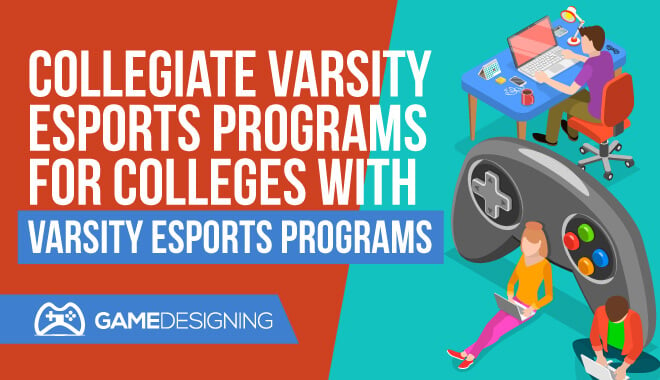
$493 million. That’s the perceived value of the global esports market in 2017. Some expect that number to triple over the next couple of years, reaching $2.5 billion by 2023.
But, with the help of advertisers and investors, that number is rising much faster.
In 2017, investors contributed $750 million, making up 50% of the worldwide market size.
Advertisers and sponsors contributed over $250 million. Those numbers put the end-of-2017 market valuation of esports at 1.5 billion dollars. End-of-year projections expect esports to be a $2.7 billion market in 2023.
That’s some serious growth…
And now, US colleges are jumping on board the global esports train:
Only seven colleges and universities had varsity esports programs in July of 2016. By 2018 there were 63 institutions.
The largest US organization is the National Association of Collegiate Esports (NACE), which was formed in 2016. NACE is “a nonprofit membership association organized by and on behalf of our member institutions” (US colleges).
The NACE program describes a varsity esports program as “the principal teams representing a college or university. Primarily these teams compete against similar teams at peer educational institutions.”
Esports, of course, are video games played competitively. This can be anything from 5 v 5 teamwork-testers like League of Legends, to 1 v 1 strategy-dominant Hearthstone, to anything-can-happen PUBG, and beyond.
Why Are College Varsity Esports a Big Deal?
The NACE website quotes an article in the June 22, 2015 issue of ESPN The Magazine, which said that 27 million people watched the 2014 championship tournament for League of Legends.
DOTA 2 pulled 20 million viewers in 2014.
Those are impressive numbers without context.
They’re even more impressive when you consider the viewership for other major sporting events that year: 5 million watched the National Hockey League’s Stanley Cup Finals. The World Series had 13.8 million. The NBA Finals had 15.5 million.
Clearly, professional esports is already a big deal.
Varsity Esports in Blowing Up
The growing popularity of college varsity esports is not just great for the future of professional esports and gaming in general (and make no mistake, it’s growing: the NCAA is already considering their role in the sport).
College varsity esports is another avenue in which colleges can attract students, celebrate the diversity of interests on campus, and invest money to benefit more of their student body.
With esports, a little investing goes a long way.
Esports training facilities are more affordable than regular sports training facilities. And, with the right sponsors, some programs don’t have to worry about supplying gaming chairs, or high-end computers, or other gear.
And an esports training facility doesn’t need a new, state-of-the-art million-dollar building. Many schools recommission old rooms that aren’t seeing much use. They gut it, spruce it up, and fill it with gaming gear.
Boom, there’s your varsity esports training facility.
When you think about the kind of money that’s dumped into sports (even state taxpayer money, for things like stadiums), it’s impressive to think that they’re getting outwatched by esports. Part of this could be the ease of viewing, since big tournaments, like the League of Legends Worlds, are free to watch and based online.
All you need is internet access. That’s significantly easier than, say, finding free MLB World Series coverage online (hint: barring free trials to service providers, a free option does not exist).
It’s accessible, it’s already popular, and now advertisers and sponsors are dumping hundreds of millions of dollars into it. If colleges continue to get on board with varsity programs (they show no signs of slowing down), this will be a “thing” in no time.
Future Implications of Esports in College?
While many in positions of power are slow to accept the place esports have in this world, everything is moving in the right direction.
The reason for the slow-to-adopt mindset probably rests in the stigma of playing video games: A lazy human’s pastime. A waste of time. Nerdy. Child’s entertainment. Just kids playing games.
The people in positions of power don’t all understand what esports really are. They don’t see the value in it, or they don’t care to see the value in it, likely because of some preconceived notions or some bad intel.
If you think about it, every college sport can be distilled to “kids playing games,” as Phil Alexander, a Miami University professor who teaches game design and co-directs the varsity esports team at Miami, said in an interview with Rolling Stone.
More colleges are joining every month, even with the $2500 registration fee instituted by NACE.
There’s another element that Alexander mentions which is really fascinating, which Brian Crecente captures well in his article: “[Alexander] sees the connection between pro players and college reversed from traditional sports. In esports…most pro-gamers’ careers end at 27 or 28 and then they want to go back to school.”
This, as Alexander goes on to point out, would mean collegiate varsity esports could be a viable end-of-career option for professional esports competitors. They could get post-career scholarships, still have a place in esports, and get the education they bypassed to go pro in games in the first place.
It seems like a real win-win.
The growth of esports has everyone excited: even cities are getting involved.
Arlington, Texas, for example, is building a $10 million stadium.
They’re talking about a 100,000-square-foot space that “will be the largest and most flexible esports stadium in the country.”
And this esports center isn’t even a new construction: they’re “transforming previously underutilized space of the Arling Convention Center,” which “showcases the adaptive re-use potential of esports. This innovative transformation of space is also comparatively inexpensive and more efficient than new construction. ”
If you’re wondering about the dynamics of varsity esports, or you’re interested in becoming a varsity player yourself, this next section is for you (Keep in mind that the list of colleges with varsity esports programs grows almost daily).
30 Strongest Varsity Esports Programs
Miami University
Miami University’s Master of Esports Management program, available both online and in a hybrid format, is a transformative journey from gaming passion to professional expertise.
The curriculum, rich in its depth and breadth, covers a spectrum of esports functions, from branding and marketing to team management, performance psychology, and even the legalities of broadcasting.
With a unique blend of online coursework and an in-person residency that offers hands-on experience with top-tier tournament organizations, students are primed to step confidently into the multifaceted world of esports management.
Boise State University
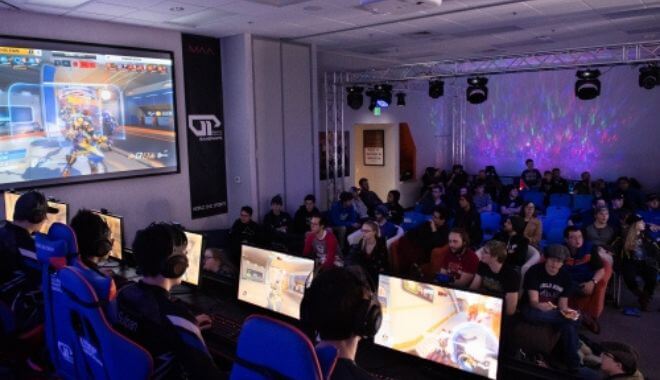
Boise State Esports stands as a beacon of excellence in the gaming community, celebrating seven years of competitive play with over 1,100 match victories. Beyond the games, the program fosters a vibrant community of students, coaches, and enthusiasts, all united in their passion for esports.
With over 2,000 live broadcasts and a commitment to inclusivity, Boise State Esports is not just about competition; it’s about building skills, camaraderie, and a legacy in the gaming world.
University of California-Irvine
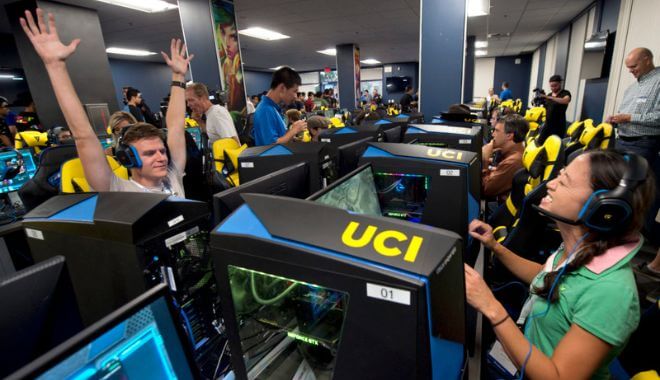
The Esports Management program at UCI Division of Continuing Education is tailored for those eager to turn their gaming passion into a thriving career in the esports industry.
This comprehensive program offers students a deep dive into the world of esports, covering its history, global trends, and the intricate relationships between developers, athletes, fans, sponsors, and media.
With courses ranging from effective communication in esports to project management for live events, students are equipped with the tools and knowledge to navigate and excel in the ever-evolving esports landscape.
University of Akron
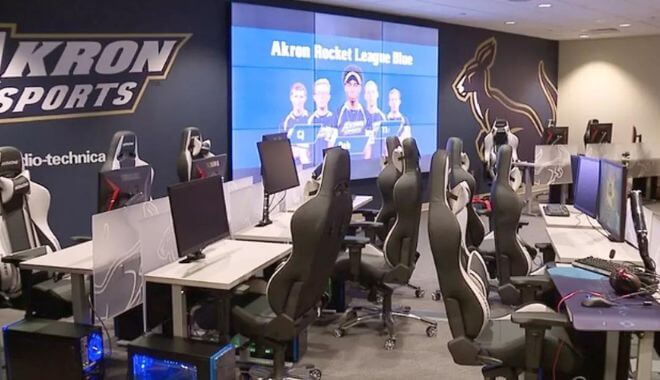
The University of Akron’s Esports program offers passionate gamers not only a competitive platform but also a chance to earn scholarships of up to $1,000 as varsity team members.
Beyond the games, the university provides a rich blend of technology and computer-related degrees, ensuring students are well-prepared for in-demand careers in the gaming sector.
Additionally, their Esports Business Certificate equips students with the knowledge and skills to navigate the rapidly evolving global esports ecosystem, meeting the industry’s demand for informed business professionals.
Western Kentucky University
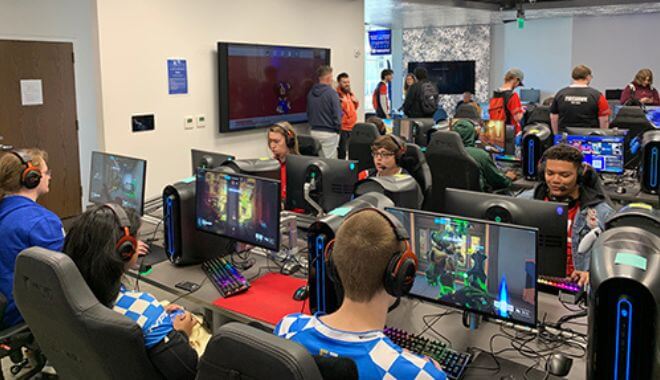
The Western Kentucky University Varsity Esports program, established in 2016, has swiftly evolved into a comprehensive esports initiative, boasting teams in League of Legends, Overwatch, Rocket League, and Valorant. With a roster of 42 student players and 4 student coaches, the program offers scholarships ranging from $1,500 to $4,000 annually, reflecting WKU’s commitment to nurturing esports talent.
Positioned to be a pioneering program in collegiate esports, WKU provides its players with state-of-the-art equipment, a dedicated esports arena, and a vision to be recognized as the premier university for esports in the nation.
Harrisburg University
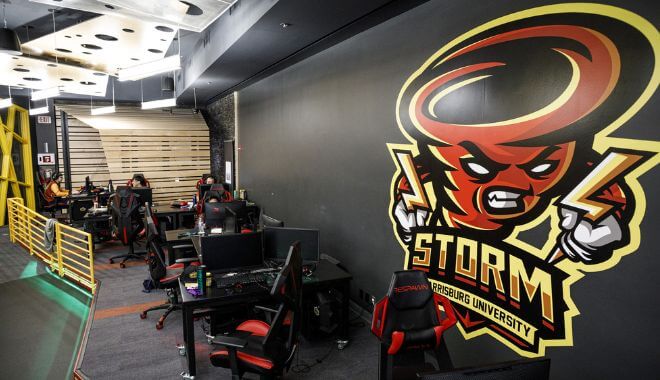
Harrisburg University’s B.S. in Esports Management, Production, and Performance is a comprehensive program designed to immerse students in the multifaceted world of esports. The curriculum delves deep into the esports ecosystem, covering everything from the history and current trends of competitive gaming to the intricacies of live event management and fan engagement strategies.
With a blend of theoretical knowledge and hands-on experiences, students are prepared to excel in various roles within the esports industry, from event production and broadcasting to leadership and business management.
Texas Wesleyan University
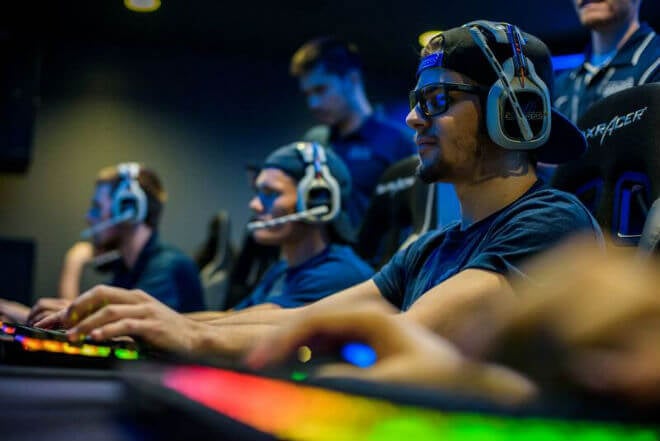
Texas Wesleyan University’s Esports & Gaming program is a holistic initiative that goes beyond just competitive gameplay, emphasizing the four core pillars: Competition, Creation, Community, and Career.
Whether students are diving into games like Valorant and FIFA, producing content, or engaging in community events, there’s a place for every gaming enthusiast.
Moreover, the program offers a unique blend of opportunities, from turning controllers into careers with a degree in sports communication to paid student positions, ensuring participants are well-prepared for the ever-evolving esports industry.
University of South Carolina Sumter
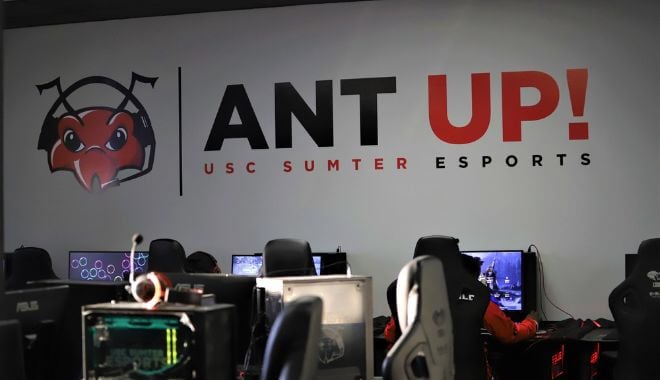
USC Sumter proudly boasts an official varsity Esports program, drawing students from both local and international arenas to compete in a diverse range of popular games, including Call of Duty, Overwatch, Rocket League, and Valorant.
As a member institution in NJCAAE, NACE, and other associations, USC Sumter actively participates in seasons created by institutions across the nation, fostering a program that encourages player growth, skill development, and equal opportunities for all.
With a vision that extends beyond just gameplay, the program emphasizes holistic player development, ensuring that every participant, regardless of skill level, has the chance to excel and evolve in the dynamic world of esports.
Northwood University
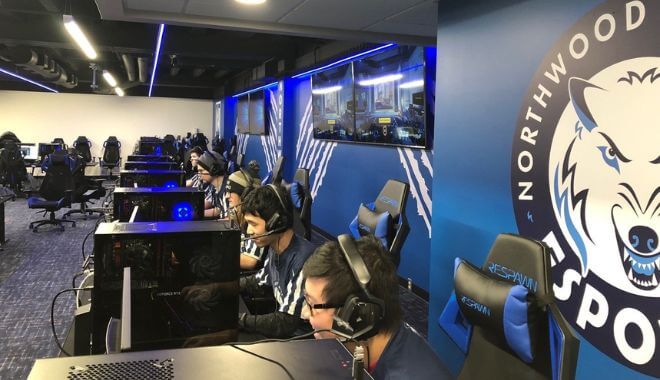
Northwood University is one of the premiere collegiate Esports programs in the country. They offer a 2,000+ square foot, state-of-the-art gaming center that caters to all levels of competitive gaming.
Since the creation of the program in 2019, their teams have quickly climbed the ranks and claimed multiple national titles in Rocket League and Overwatch.
Fisher College
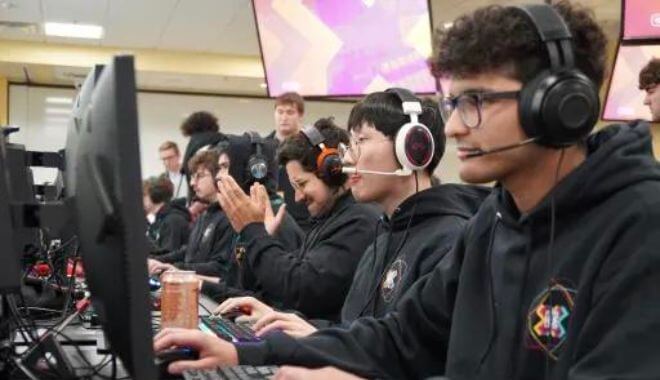
Fisher College’s esports program stands as a pioneering force in the Boston area, offering students a competitive platform led by nationally ranked coaches and a roster of over 100 elite players. Beyond the thrill of the game, the program equips students with real-world skills, from managing esports events to mastering live-stream production.
With monthly industry TED Talks and a state-of-the-art gaming arena, Fisher College is shaping the next generation of esports professionals.
St. Clair College
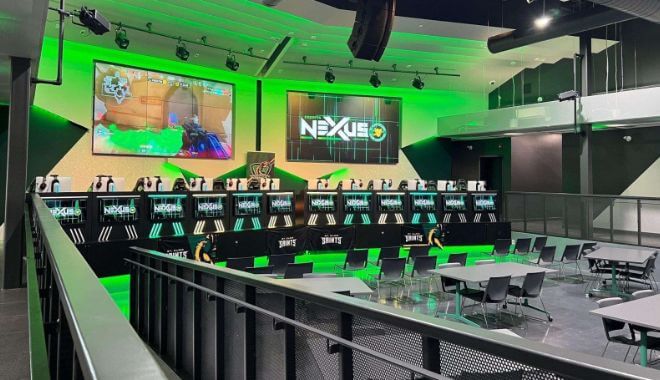
St. Clair College’s Esports Administration and Entrepreneurship program is a beacon for those eager to dive deep into the multifaceted world of esports.
This two-year diploma program not only delves into the business and entrepreneurial side of esports but also offers hands-on experiences, from organizing large-scale events to mastering content creation for platforms like Twitch and YouTube.
With state-of-the-art facilities like the Nexus and strong industry connections, students are primed for success in the burgeoning esports industry.
University of St. Thomas

The University of St. Thomas’s Esports program is a gateway to the exhilarating world of esports, offering students a comprehensive insight into the multifaceted gaming industry. Beyond fostering a community for gaming enthusiasts, the program equips students with the tools to excel in various esports careers, from broadcasting and event management to entrepreneurship and talent management.
With partnerships like TEXSEF and NASEF, students are primed to lead in the rapidly evolving esports landscape.
Drexel University
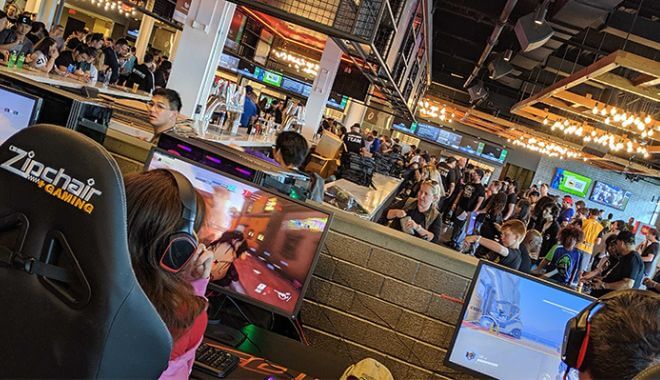
Drexel University’s LeBow College of Business offers a cutting-edge BSBA in Esport Business, tailored for students aiming to carve a niche in the booming electronic sports and gaming sectors. This pioneering program, one of the first of its kind globally, seamlessly integrates core business principles with specialized courses in game design, law, and event management.
With a rich curriculum that includes game strategy, entertainment, and digital media, students are equipped to navigate and lead in the multifaceted world of esports business.
Maryville University
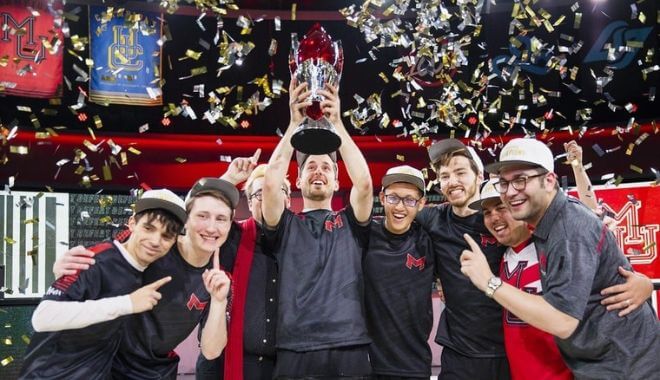
Maryville has traditionally made a name for itself in college esports in League of Legends, and that’s been no different in 2023.
The three-time CLOL champions were runners-up in this year’s CLOL championship but did win the NACE Spring Finals for League of Legends. Outside of League, the Saints won the NACE Spring Finals in Overwatch and placed among the top four in Blizzard’s Overwatch Collegiate Championship
Oklahoma City University
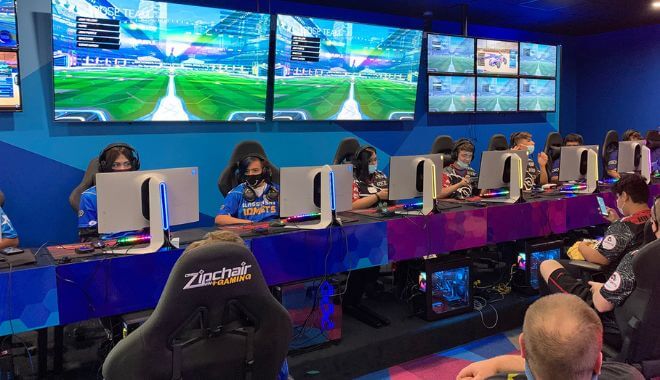
Oklahoma City University’s Esports program is more than just competitive gaming; it’s a holistic approach to player well-being and professional development.
The program fields varsity teams in popular games like Call of Duty and Overwatch, while emphasizing physical and mental wellness, from wrist strength exercises to specialized workshops addressing the unique needs of esports students.
Moreover, with the integration of the Esports Management degree, students are primed for hands-on experience in the industry, ensuring they’re equipped for diverse roles from game production to esports event management.
Rochester Institute of Technology
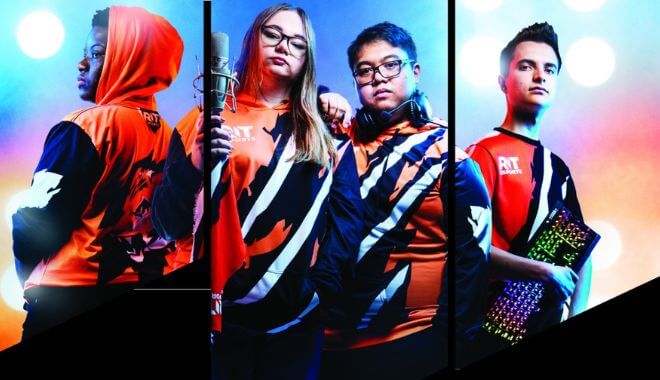
Rochester Institute of Technology (RIT) offers an esports experience that’s more than just gaming—it’s about community, opportunity, and school pride.
Since its inception in 2016, RIT Esports has grown to be one of the nation’s premier collegiate esports programs, boasting nearly 300 players, over 2,000 community members, and participation in 18 different video games.
Beyond competitive play, RIT provides a holistic approach, emphasizing player wellness, offering an Esports Management degree, and fostering a vibrant community where students can engage in roles ranging from game strategy to live-stream production.
Ohio State University
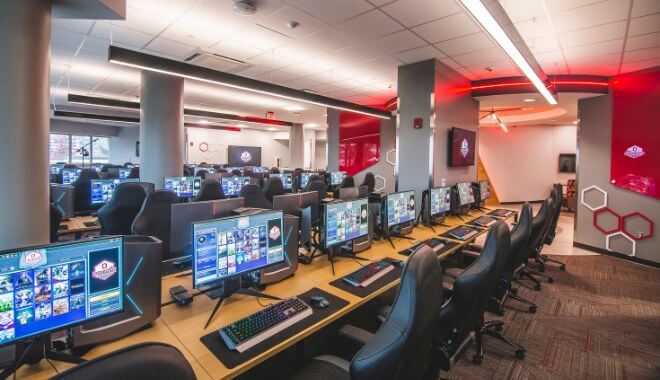
The Ohio State University’s esports initiative is not just about gaming—it’s a comprehensive fusion of academics, research, and student engagement, placing the university at the forefront of the rapidly growing esports industry.
Collaborative efforts span across various departments, including the Wexner Medical Center, the Office of Student Life, and multiple colleges under the Office of Academic Affairs. Together, they conduct research, curate learning experiences, and develop programs, ensuring students have unparalleled opportunities in the realm of esports and game studies.
Winthrop University
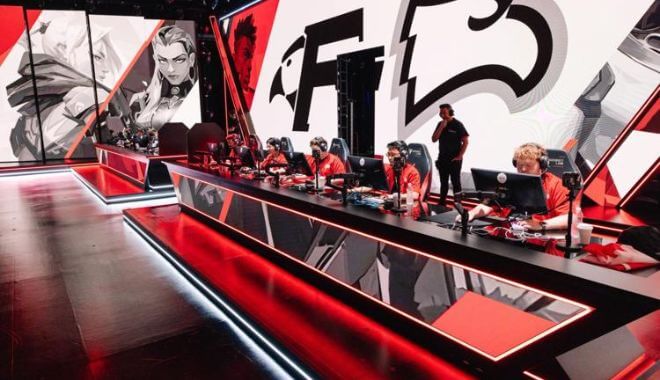
Winthrop University’s esports program, established in 2019, has rapidly ascended to be one of the premier varsity esports programs in Division I athletics, clinching two national championships within its first 18 months. Not just limited to competitive play, Winthrop’s esports initiative offers a diverse range of roles from video editing and graphic design to stream production and casting.
As the program continues to expand, including JV and club divisions, it remains committed to providing an inclusive environment for gamers at all levels, all while ensuring students receive a top-tier education, as evidenced by Winthrop’s ranking as the #6 public university in the south.
West Virginia University
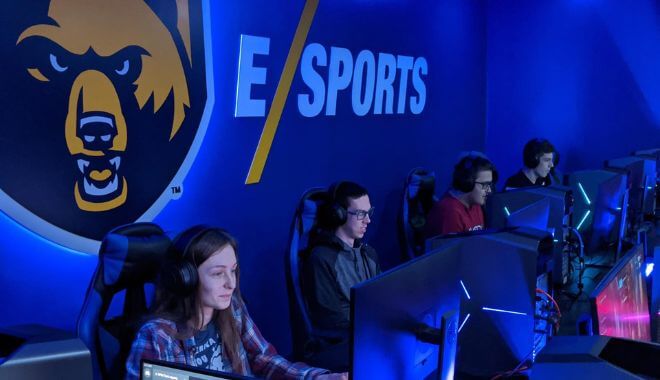
West Virginia University’s esports initiative is more than just competitive gaming; it’s a comprehensive blend of championship-winning varsity programs and the innovative Esports Business and Entertainment (ESPT) academic program.
Students are not only immersed in the competitive realm, competing in games like Call of Duty and Rocket League, but they also gain hands-on experience in event management, communications, and other industry essentials.
Designed with insights from esports industry experts, WVU’s program ensures students are equipped with the skills and knowledge to thrive in the rapidly evolving esports landscape.
James Madison University
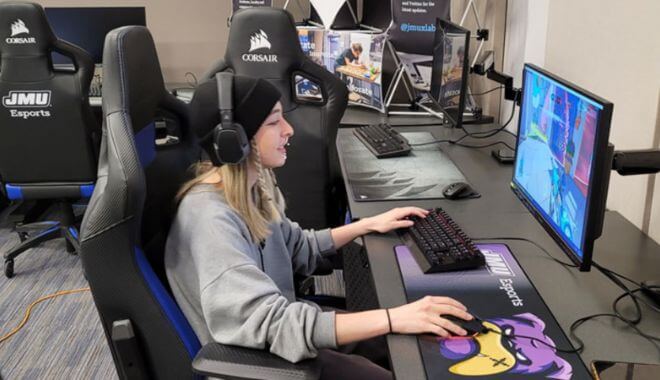
James Madison University’s Esports program is a vibrant hub for a diverse community of gamers, offering more than just competitive play. Rooted in the ethos of collaboration and learning, the program integrates esports, video games, and gamification, allowing students to apply classroom knowledge in supporting the varsity teams.
Beyond the games, JMU Esports fosters an inclusive environment where students can connect, share experiences, and build valuable professional relationships, all while being mentored by a network of alumni, students, and industry partners.
Illinois Wesleyan University
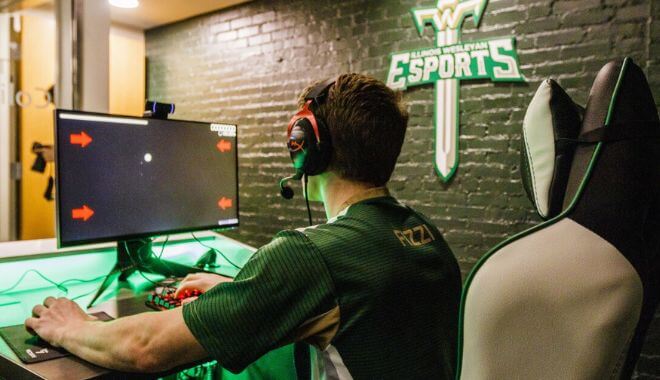
Illinois Wesleyan University’s Esports program is a dynamic blend of competition and creativity, fielding teams in games like League of Legends, VALORANT, and Super Smash Bros. Ultimate, all while competing on a national stage.
Beyond gameplay, the program offers students unique media opportunities, allowing them to delve into casting, production, graphic design, and content creation in a state-of-the-art broadcast studio. With dedicated coaches for each varsity title, players receive tailored training, focusing on individual mechanics, team strategies, and fostering a growth-oriented mindset.
University of Washington
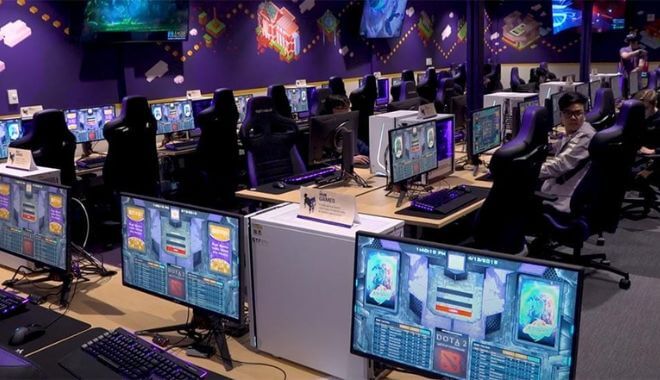
The University of Washington’s Esports, Gaming & Broadcasting course is a deep dive into the multifaceted world of gaming and interactive media. Students, from incoming 10th to 12th graders, get the opportunity to explore competitive esports, game development, broadcasting, and the crucial aspect of diversity and inclusion within the industry.
Beyond theoretical knowledge, participants gain hands-on experience in broadcasting esports matches, covering roles from production and directing to marketing, all while interacting with seasoned industry experts to glean insights into potential gaming careers.
Shenandoah University
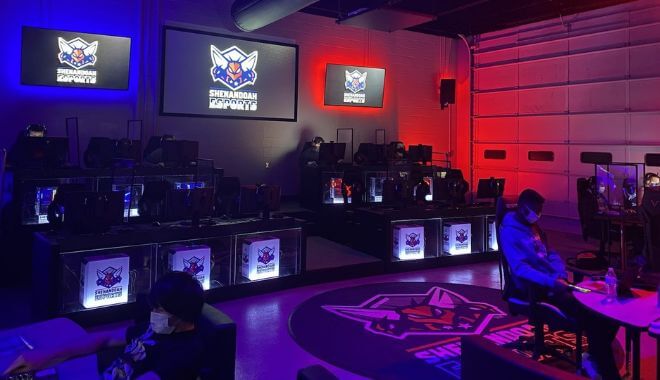
Shenandoah University’s Esports program is a trailblazer in the academic and competitive gaming landscape, aiming to mold students into innovators and leaders within the esports ecosystem.
Beyond just gameplay, the university offers a diverse range of academic programs, including Esports Management degrees and certificates, ensuring students are well-prepared for the multifaceted esports industry.
With a vision to set the gold standard for professionalism, Shenandoah’s esports initiative combines competitive varsity teams, hands-on learning experiences, and a commitment to going beyond gaming.
Tiffin University
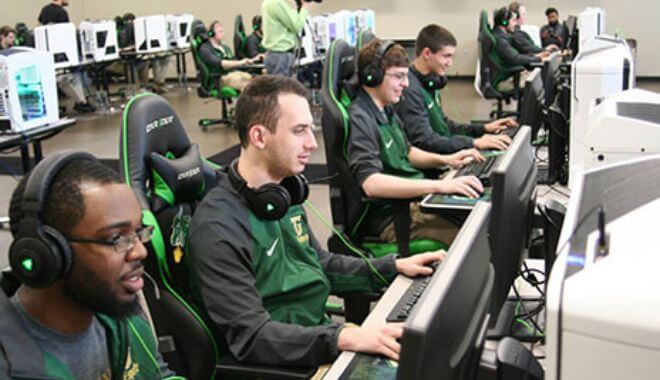
Tiffin University’s Esports Management program, nestled within its broader Sports Management curriculum, is a forward-thinking initiative tailored for the digital age of competitive gaming.
Drawing from the expertise of industry professionals, the program offers students a deep dive into the world of esports, from the intricacies of game strategies to the business side of the esports industry.
With a strong emphasis on real-world experiences, students are provided with unique opportunities to intern and collaborate with major esports organizations, ensuring they are well-prepared to navigate the rapidly evolving esports landscape.
Midland University
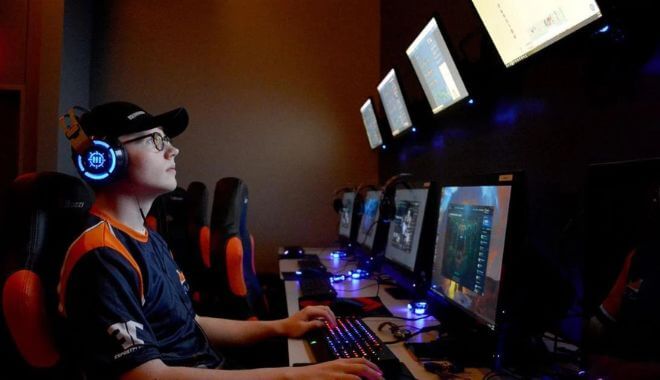
Midland University’s Esports program offers passionate gamers not only a competitive edge but also a unique pathway to finance their college education.
Recognizing the immense growth and potential of the esports industry, the university provides students with opportunities to compete in popular games like Valorant, League of Legends, and Overwatch, all within a state-of-the-art gaming arena sponsored by HyperX.
Beyond gameplay, Midland University emphasizes the broader scope of esports, offering scholarships for eligible participants and fostering a community where students can turn their gaming prowess into a lucrative career, all while pursuing their degrees.
Saint Peter’s University
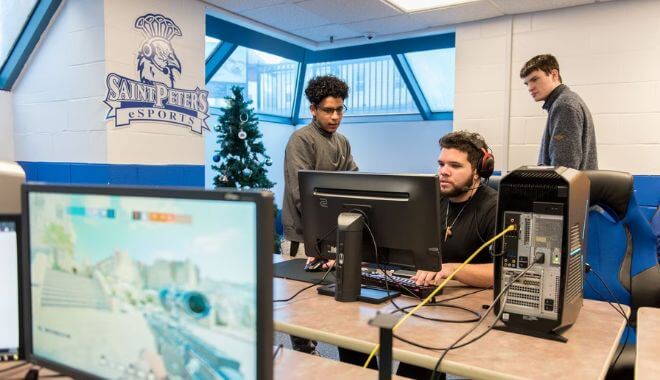
Saint Peter’s University stands at the forefront of the esports industry with its Esports Business specialization, one of the first of its kind in the nation. This program dives deep into the rapidly expanding world of esports, equipping students with the skills and knowledge to thrive in a sector boasting a global audience of over 500 million.
The curriculum covers a wide range of topics, from esports digital marketing and consumer engagement to event planning, ensuring graduates are well-prepared to enter an industry that values strategic thinking, creativity, and intellectual curiosity.
Caldwell University
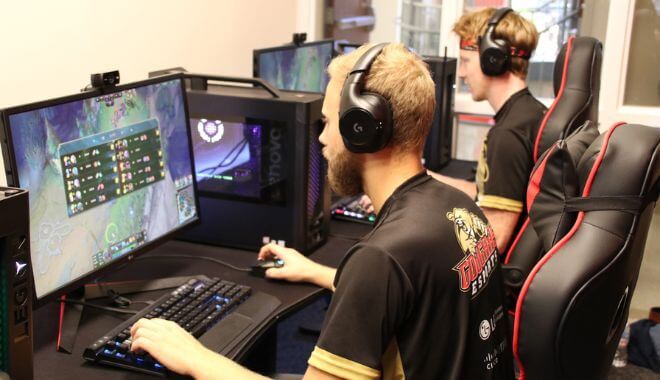
Caldwell University’s Bachelor of Science in Esports Management is a pioneering program designed to equip students for the burgeoning electronic sports and gaming sectors.
Nestled within the esteemed School of Business and Computer Science, the curriculum delves into the multifaceted world of esports, encompassing business, digital marketing, event planning, ethics, and the sociocultural implications of esports.
Beyond theoretical insights, students benefit from Caldwell’s robust business resources, hands-on internships, international travel study trips, and the opportunity to engage with the university’s competitive Esports team, one of the campus’s most popular clubs.
Ashland University
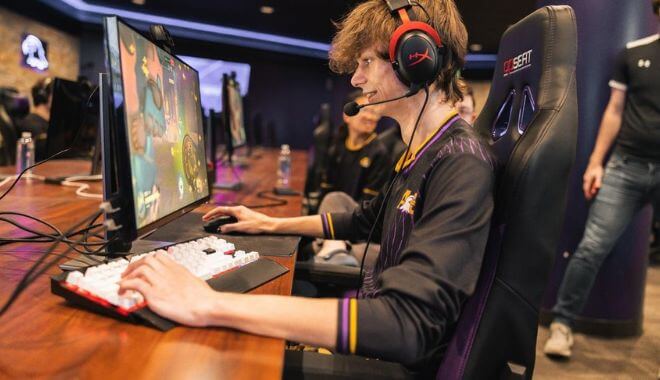
Ashland University’s Esports program is a dynamic fusion of competitive gaming and academic excellence, tailored for those who are passionate about making their mark in the esports arena. Not only do students get the chance to compete in high-energy matches, but they also have the potential to earn scholarships, all while working towards their bachelor’s degree in a supportive environment.
With a history dating back to 2018, making it older than 75% of other university esports programs, Ashland ensures students benefit from a structured team environment, a well-organized competition schedule, and invaluable coaching on balancing gaming with academics.
Pace University
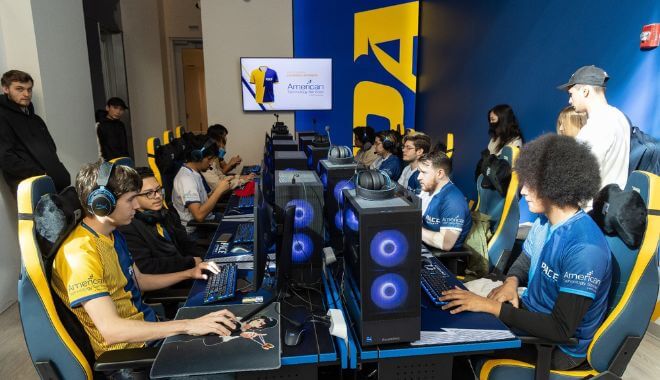
Pace University’s Esports program is a harmonious blend of competitive excellence and community spirit, with its origins tracing back to 2015 and an official launch in 2021. Offering a diverse gaming portfolio, including titles like League of Legends and Valorant, the program celebrates both competitive achievements, with two ECAC National Championships.
Beyond the games, Pace places a strong emphasis on inclusivity, curricular development, and career pathways, ensuring students are equipped for both the esports arena and the broader gaming industry.
Emporia State University
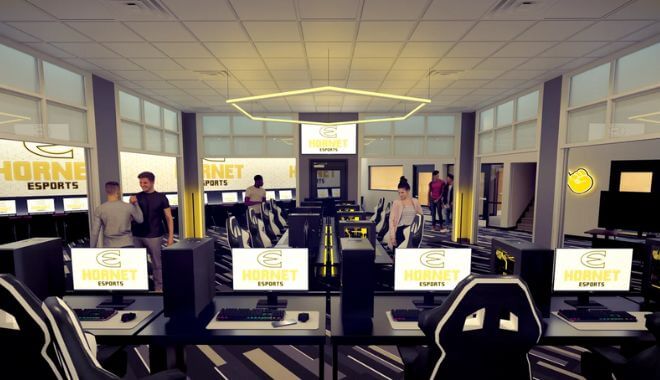
Emporia State University’s new Esports program, launched in April 2023, offers students a comprehensive experience that extends beyond just competitive gaming.
With a focus on vital skills applicable both during college and post-graduation, the program boasts competitive varsity teams in games like Overwatch and Valorant, and uniquely positions students to not only play but also coach, manage, and promote their teams on social media.
Additionally, the program’s state-of-the-art gaming arena, backed by both the City of Emporia and the ESU Foundation, doubles as a high-tech computer lab, enabling students to undertake expansive projects and engage in an E-Ventures academic component that hones skills in technology, illustration, design, and coding.
Sources
https://nebraskapublicmedia.org/en/news/news-articles/a-strategic-investment-nebraska-schools-going-all-in-on-esports/
https://www.harrisburgu.edu/news/hu-places-on-top-10-of-colleges-with-superior-esports-programs/
https://www.theitem.com/stories/with-numerous-upgrades-in-place-usc-sumter-esports-team-returns-to-normalcy,381741
https://esports.northwood.edu
https://www.fisher.edu/esports
https://www.stclaircollege.ca/programs/esports-administration-and-entrepreneurship
https://www.stthom.edu/Academics/Esports




Leave a Reply